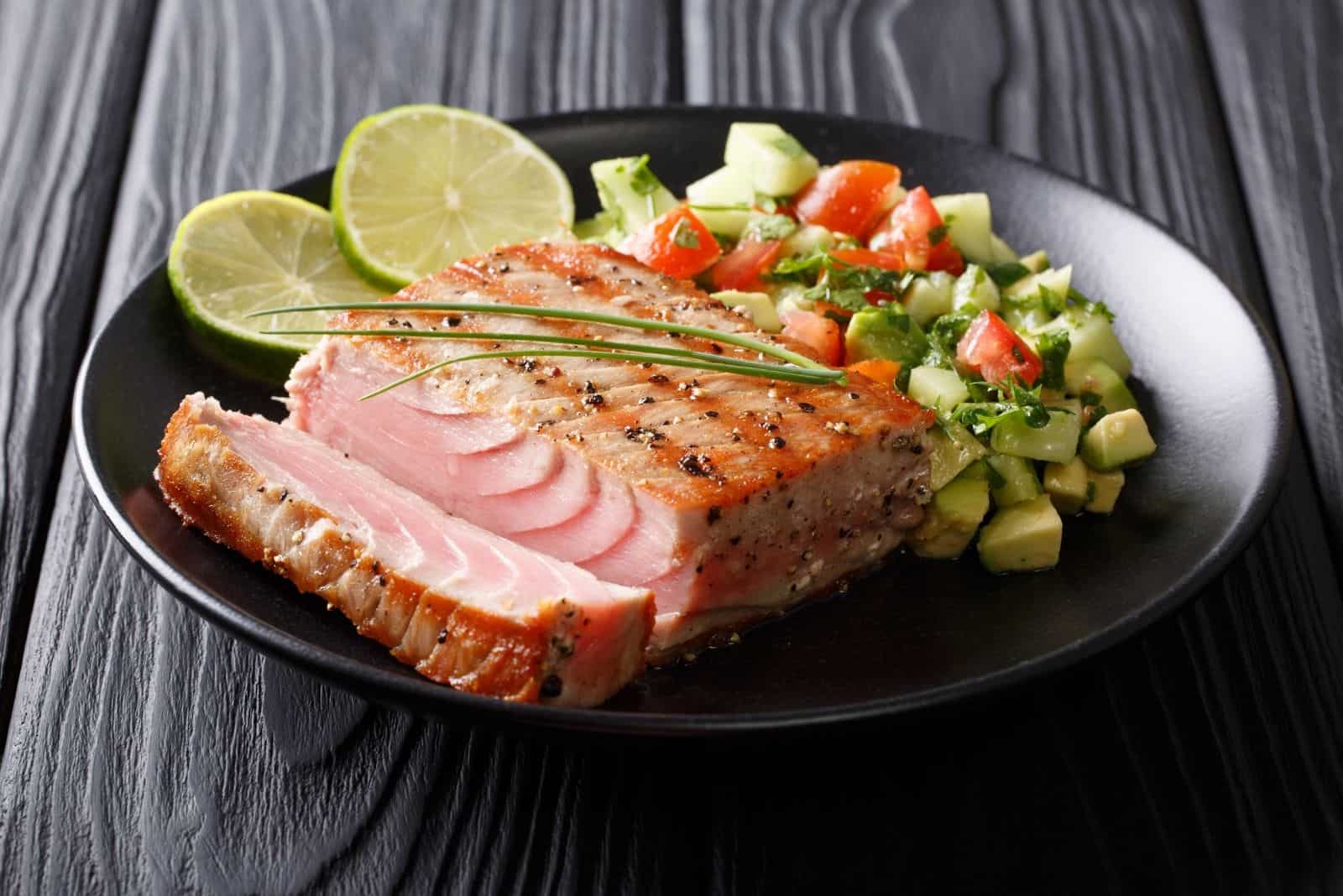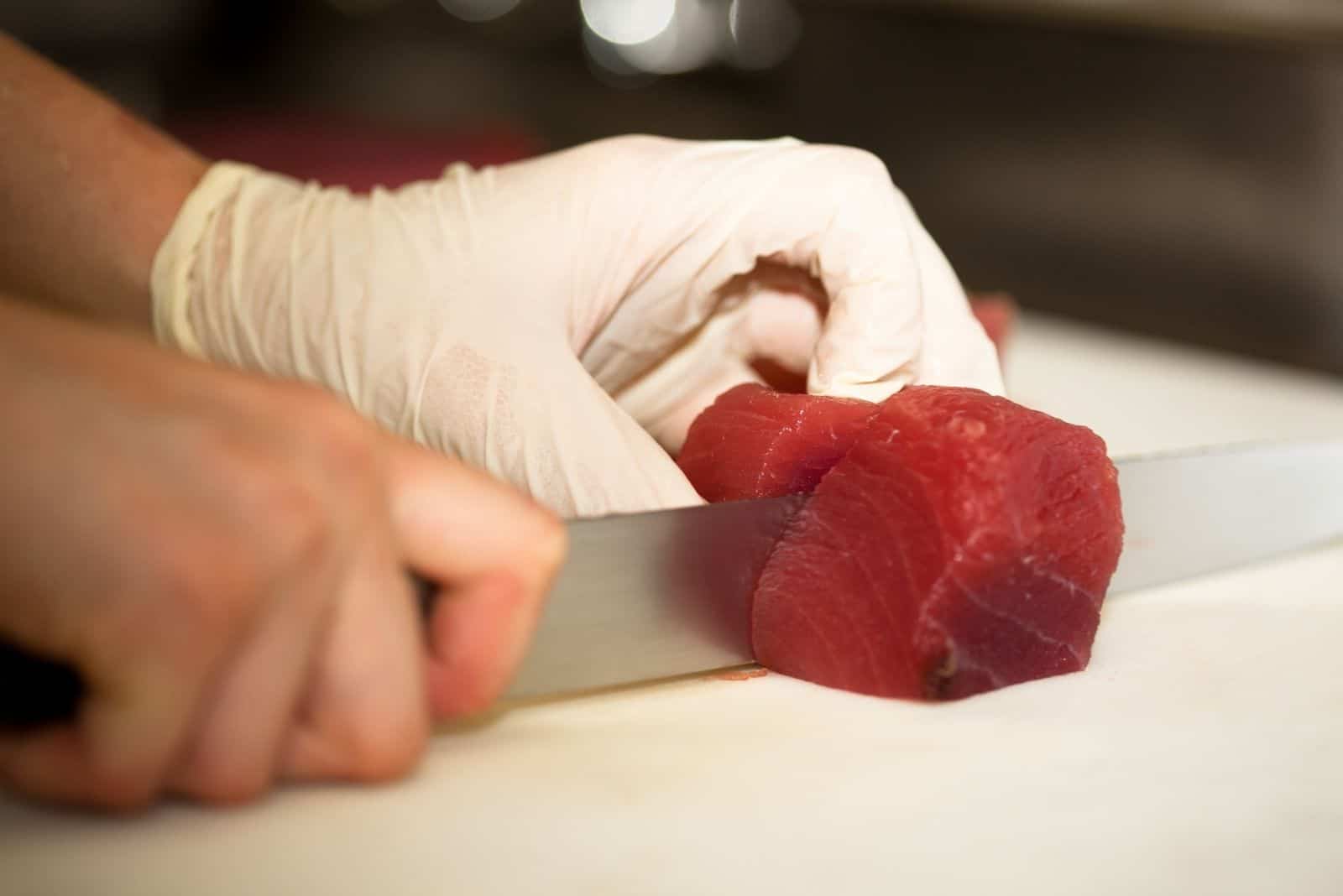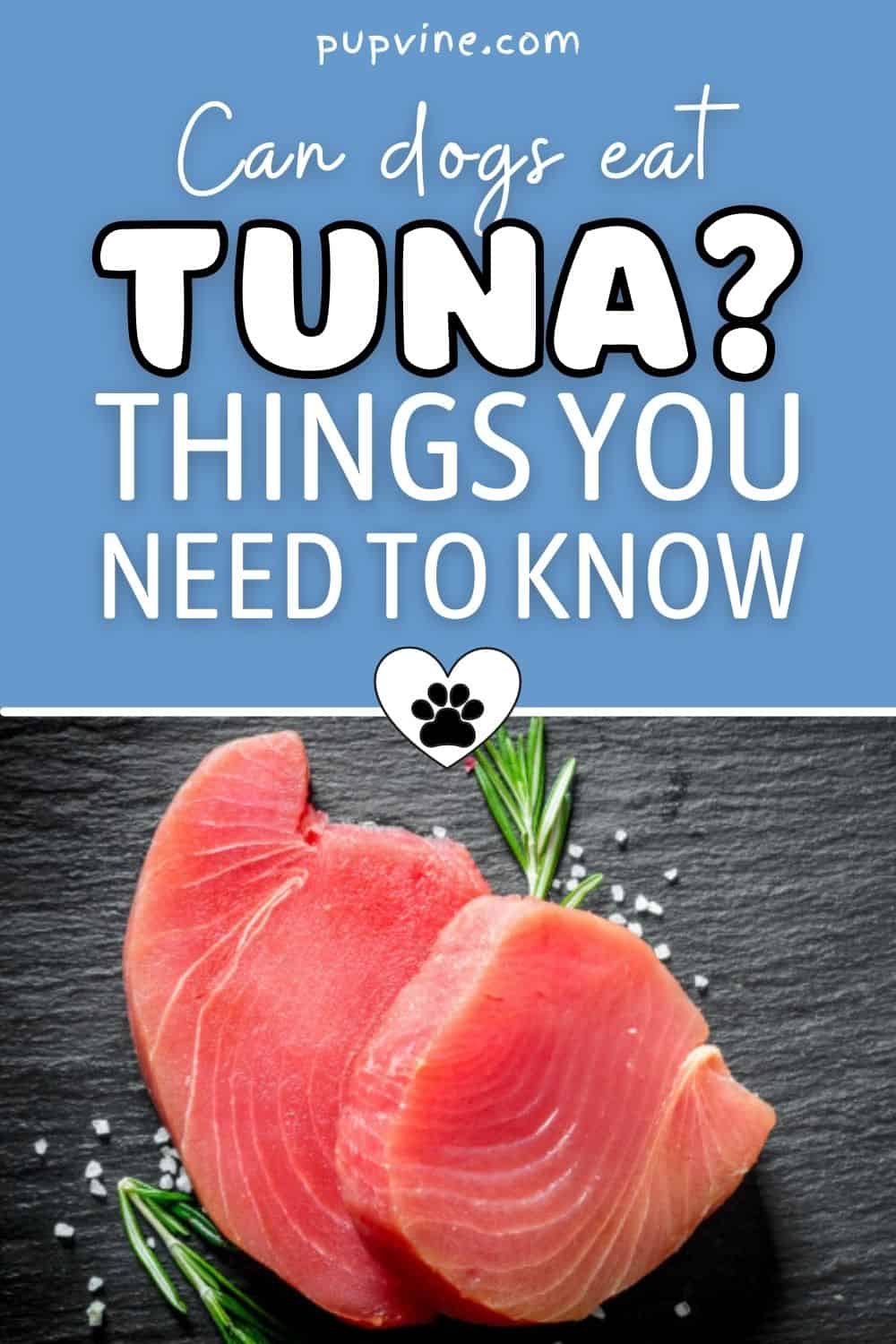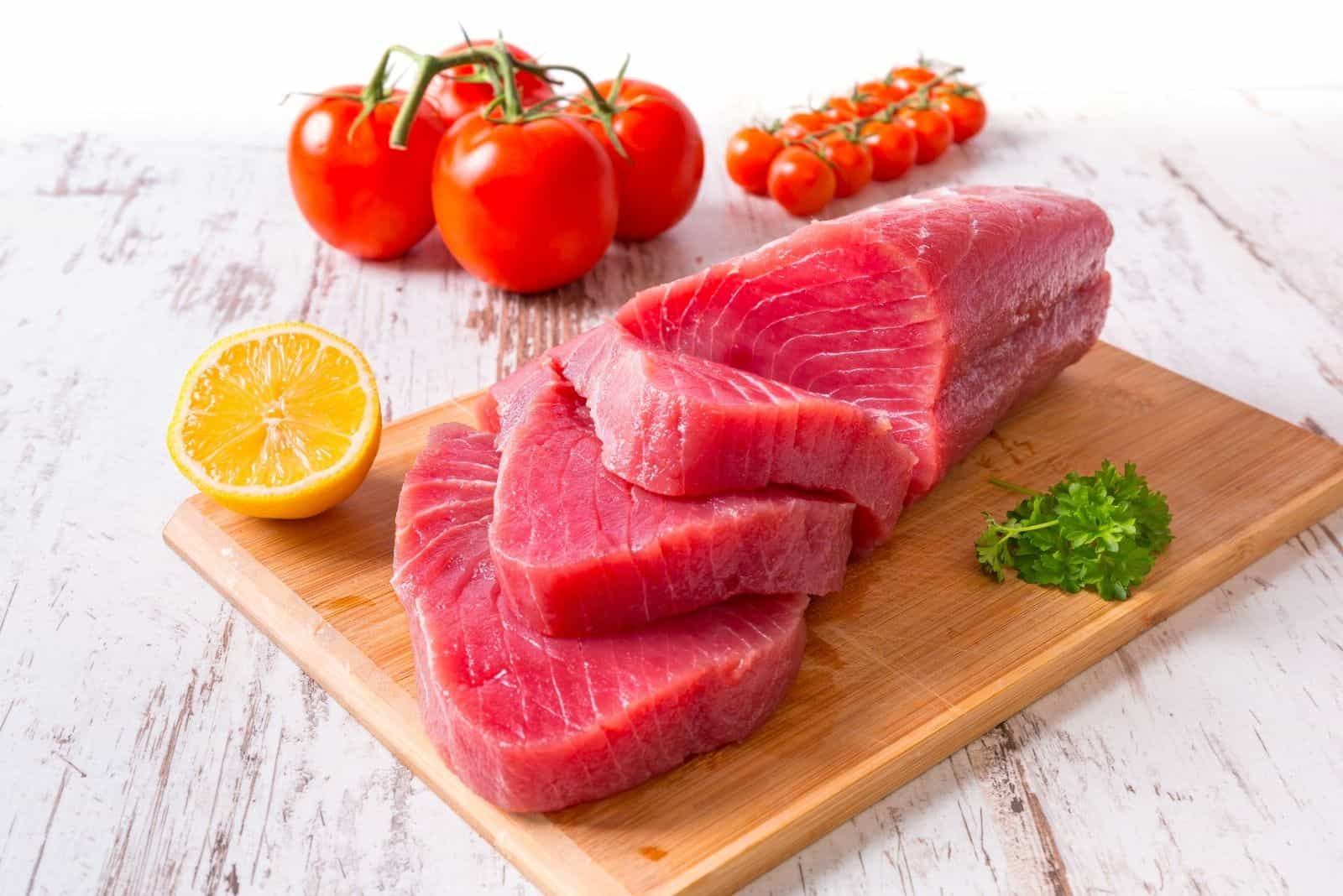One thing almost no one can resist is a puppy face. How can you resist a dog who is begging you for a bite of your lunch?
Unfortunately, some things that are good for you can be terrible for your pooch. But is this the case for something as healthy as tuna?
Knowing what your pet can and cannot eat is the key to having a healthy, happy puppy.
So, can dogs eat tuna?
Is it beneficial, or will it cause harm to your pooch? We’ll explore this further.
Benefits Of Eating Tuna

In most cases, tuna is safe for dogs.
Actually, tuna is one of those human foods that has plenty of nutritional benefits for your dog.
This is because it’s high in lean protein, which is great for muscles.
Also, it’s low in harmful fats that cause health problems such as obesity and high cholesterol.
Tuna is rich in many essential vitamins and minerals that are necessary for your pup’s overall health.
This includes vitamin D, B3, B6, and B12, all of which are great for improved metabolism and high energy levels.
It’s also full of potassium, selenium, and magnesium, which are excellent choices for healthy muscles and organism cells. Tuna is great for bones, as well, since it’s rich in phosphorus.
One thing tuna is known for is the amount of omega-3 fatty acids it contains.
Fatty acids are vital for your dog’s coat, and if you’ve noticed that your pooch has dull and flaky skin, foods with omega-3 and omega-6 fatty acids could help them with this problem.
Not just that, but fatty acids also help lower cholesterol levels, reduce inflammation, and boost cardiovascular health.
If you take a close look, this is similar to the many benefits tuna has for humans, as well.
All in all, if you’ve ever wondered, “can dogs eat tuna?” – you should know that tuna fish is a fantastic addition to your dog’s diet since it is a novel protein.
If you own a dog prone to food allergies, you know what this means, but we’ll explain just in case.
Just like humans, dogs can have allergies to many foods. Usually, the culprits are proteins found in most meat, including chicken and beef.
In fact, it’s recommended you switch the type of meat you feed your dog from time to time, so they have variety in their diet.
Some proteins aren’t common to dog foods, and they are called ‘novel proteins’ since dogs don’t eat them as often.
Common sources of novel proteins are duck and venison, but in the last few years, tuna fish has been used more and more in commercial dog foods to help with diversifying their diet.
This is yet another pro to adding dog tuna to your pup’s diet.
Risks Of Eating Tuna

So, tuna is not just safe but has many health benefits for dogs. However, are there some issues that can occur if dogs eat this type of fish?
Dogs should eat tuna in moderate amounts. It would be best if you didn’t make it a part of its daily diet but rather give it to your dog as an occasional treat.
Firstly, this is because tuna fish has high levels of mercury, which isn’t a good thing.
This heavy metal can be poisonous if you eat it in large amounts.
While this is true for humans, it’s even more harmful to dogs, who are much smaller than their owners. As a result, their tolerance levels are low.
If you worry you might have gone overboard with feeding this fish to your dog, these are some of the symptoms you need to look for:
• Watery diarrhea
• Vomiting
• Vision problems
• Tremors
• Loss of feeling in the limbs and paws
• Hair loss
• Blood in vomit or diarrhea
• Anxiety

Photo from: @suchgooddogs
Suppose you notice any symptoms of mercury poisoning. In this case, it’s essential to take your pooch to the vet as soon as possible.
While rarely deadly, it can still damage your four-legged companion’s health.
Another thing that’s bad about saltwater fish such as tuna – especially canned tuna with added salt – is the high amount of sodium.
When consumed in large amounts, sodium is very dangerous to a dog’s health. Because of this, dogs should always eat tuna in small to moderate amounts.
Some signs of sodium poisoning include:
• Convulsions
• Excessive urination
• Lethargy
• Loss of appetite
• Nausea
• Swelling of the tongue
• Thirst
Sodium poisoning can lead to many dangerous conditions, such as epilepsy and pancreatitis.
Also, while tuna is a great protein source, high levels of protein aren’t always such a good thing.
In fact, tuna has so much protein in it that some dogs might find it difficult to digest, especially if they don’t consume it regularly.
The best thing you can do whenever you introduce new types of food to your pup is to monitor him closely.
Even the healthiest foods can sometimes upset a dog’s stomach if they aren’t used to it.
One of the things you should keep a close eye on is his stool consistency. Any changes in his toilet habits mean that he isn’t adapting too well to the new diet.
Vomiting is another bad sign that means his stomach is having issues.
How Much Tuna Should Your Dog Eat?

We’ve already mentioned that the best way for your dog to eat tuna is if he has it occasionally, along with his kibble.
He shouldn’t eat it regularly, as it can cause health issues. But exactly how much is considered too much?
First off, if you didn’t give your pup tuna fish, but he’s stolen a bite from your plate during lunchtime – this is perfectly fine (except for the stealing bit).
It won’t hurt them, and there is no need to worry.
The rest depends on the type of tuna you’re giving your friend.
Fresh tuna is the one you can give most often. A dog can eat a piece or two a few times a week without having any health issues.
Keep in mind that the smaller the dog is, the less tuna he should eat. A dog’s weight dictates how much of a certain food he can have, and the same goes for tuna.
If you want to feed your pup canned tuna, it’s especially important you know their weight beforehand, as it should be fed in much lower amounts.
For example, if your dog weighs around 20 lbs, he can have a can of tuna approximately once a month – no more often than every three weeks.
A 40 lbs dog can eat a can of tuna on average about once every nine days.
And a large dog who weighs 90 lbs can eat an entire can of tuna every five days.
If you’re uncertain how often you can give tuna to your pup, consult your veterinarian, as he is the one who could give you the best insight into your dog’s health and preferred diet.
What About Older Dogs And Puppies?

It’s important to note that everything we’ve mentioned before applies only to healthy adult dogs. Puppies and seniors are a whole other story.
In fact, puppies shouldn’t be eating tuna at all.
This is because a puppy’s digestive and gastrointestinal system is still developing, and this goes on for around a year.
Until your pet is up to a year old, it would be best to avoid giving them certain foods like tuna.
Again, tuna is not poisonous to dogs. It won’t cause any harm to your puppy if he manages to get his paws on a little bit of tuna steak.
Still, it would be best if you didn’t intentionally give tuna to your little companion.
The same goes for senior dogs with digestive issues. If your older pooch is entirely healthy, consult with your vet to see if he can continue eating tuna if this is something he’s accustomed to having.
However, if you’ve never given tuna to your dog before, or if he has any issues with his digestive system, you should avoid giving him any tuna whatsoever.
Some older dogs will still love having fish-tasting kibbles and treats, and dog owners can’t resist giving them some.
If this is the case and your pup doesn’t have any stomach issues, you might be able to continue doing so.
Just make sure you mention this to your vet during your next appointment.
Are Some Types Of Tuna Better Than Others?

Overall, dogs can eat any type of tuna humans can. This includes raw, cooked, or even canned tuna. However, there are some things worth mentioning.
If you ever give your dog raw fish, no matter if it’s tuna or some other species, always clean it thoroughly and remove all the bones from it. The same goes for fish sticks.
Dogs are known for being voracious eaters. They will rarely carefully chew their food, and they’d rather wolf it down.
This can lead to some tiny yet sharp bones of raw tuna piercing their throats.
Even if they manage to swallow it, a bone can cause serious damage to a canine’s digestive system.
If you give your pooch cooked tuna, don’t add any spices. This includes salt, as well.
Also, it would be best if you baked or broiled it, as these methods help tuna keep all of its nutritional value.
If you worry this will render fish tasteless, keep in mind that dogs don’t really care about spices.
In fact, they prefer natural-tasting meat, and seasoning will not only make tuna taste worse than before, but it can also make their stomachs upset.
Canned tuna can be a bit tricky, as it contains a lot of oil. Because of this, it’s much better to give your pup tuna packed in water instead of oil.
While oil isn’t really dangerous on its own, it is very high in calories, while it doesn’t have any nutritional value.
It’s just empty calories that increase the chances of a dog becoming morbidly obese.
Not just that, but consuming too much oil can inflame the pancreas and cause pancreatitis. This chronic illness might affect your dog’s quality of life.
If you feel like you must add something to your dog’s tuna for taste, you might consider adding mayo.
If anything else, you shouldn’t be concerned about your pup eating a bit of your tuna mayo sandwich.
Of course, don’t go overboard, as mayo contains plenty of saturated fats, thus making your dog fat.
Also, some mayonnaises include plenty of ingredients that might harm your dog. For example, mayo can contain onion and garlic, both of which are toxic to canines. Always read labels carefully.
Tuna juice, a liquid that some tuna foods contain, is suitable for dogs, and it doesn’t contain many bad things that tuna fish itself does.
While you still shouldn’t give it to your pup every day, you can include it in his diet more often.
Still, you shouldn’t suddenly just give him too much juice at once. It’s better to buildup slowly so that he can get accustomed to it.
For such huge omnivores, dogs have sensitive stomachs. Any new food can cause them plenty of health issues, and you don’t want that.
If you’ve just started giving tuna to your Fido, watch out for diarrhea and vomiting.
Also, inspect the source of your tuna and make sure it’s FDA approved.
There are 29 different tuna species, but only five are safe for human (and dog) consumption. This includes albacore, skipjack, bluefin, bigeye, and yellowfin.
Commercial Dog Food With Tuna

Many commercial dog food brands you can find on Amazon and similar sites have started adding tuna to many of their recipes.
This makes food more suitable for dogs with food allergies, and it can provide a more balanced diet. It might also be appealing to picky eaters.
However, it might not always be a great idea to add commercial dog food with tuna to your dog’s daily diet.
This is because you can never know the source of the tuna that the brand uses and how much mercury there is, and even how much real tuna is in the food you’re buying.
For example, cheaper dog foods usually contain tuna that isn’t safe for human consumption.
This type of tuna serves as a cheap source of novel protein but can contain unsafe levels of mercury.
If you decide to buy such food for your pup, always thoroughly research the brand and what type of tuna they use.
Keep in mind that high-quality food with tuna usually comes with a higher price tag. This alone might be enough to make you feed it to your dog not too often.
Can Dogs Eat Sardines?

If you plan on introducing fish to your dog’s diet, you might consider giving them sardines instead.
Sardines have all the health benefits tuna has, but they come with much lower risk because they have a much lower amount of mercury than most other saltwater fish.
The same goes for whitefish or flounder, which don’t keep mercury in their systems.
In fact, even some smaller fish from the tuna species, such as skipjack or albacore tuna, don’t contain as much mercury as many larger tuna species.
This is something worth considering should you decide to change your dog’s diet a bit.
Other Human Foods That Are Safe for Dogs
Other than tuna, some other human foods are safe for dogs. This includes:
- Artichokes
- Brussels sprouts
- Paprika
- Carrots
- Fig newtons
Just keep in mind that any new food should be introduced with caution. Dogs are prone to food allergies, and certain foods can give them many problems.
Even dogs who don’t experience an allergic reaction might have stomach problems if they aren’t used to eating that specific type of food.
The Verdict
So, if you’ve ever wondered, “can dogs eat tuna?” the answer would be yes, but in moderate amounts.
Any dog owner or nutritionist should also take the additional step of researching a few things before adding tuna to a dog’s diet.
First off, it’s essential to know the source of the tuna in any food you plan to give to your dog.
A general rule of thumb is that the smaller the fish, the less mercury it contains. This isn’t carved in stone, though, so make sure to do your research.
Also, take note of your pooch’s weight, then calculate how much tuna he should eat on a monthly basis. Bigger dogs can eat more tuna than smaller ones.
Puppies and dogs with stomach issues shouldn’t eat any tuna whatsoever, as their enzymes don’t work that well, and it can upset their digestive systems.
Ensure the tuna you plan on giving to your dog doesn’t contain any harmful ingredients or seasoning, and raw fish should always be deboned correctly.
Finally, if your dog can’t eat tuna for any reason, but you’d like to give him food with a novel protein, there are other options you might consider.
These include poultry, lamb, or even wild boar as a protein source!
The health of your four-legged friend should always be a priority. Make sure his diet meets all of his specific needs.

